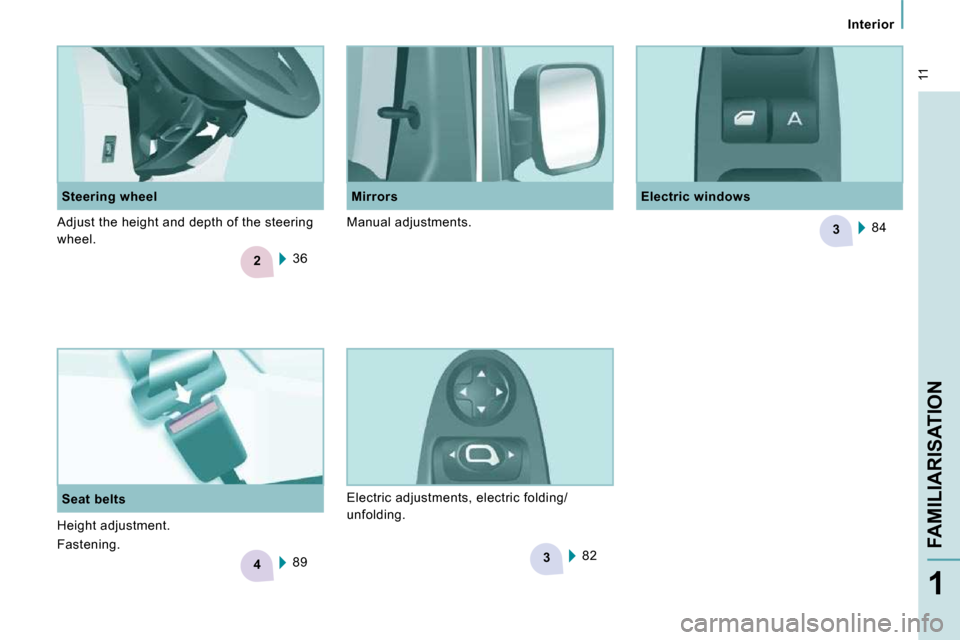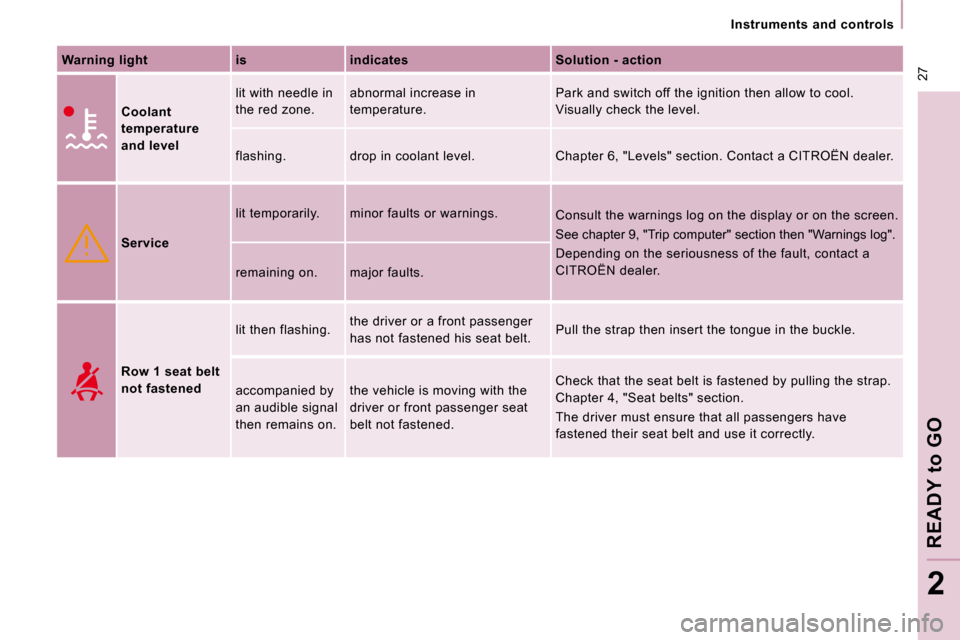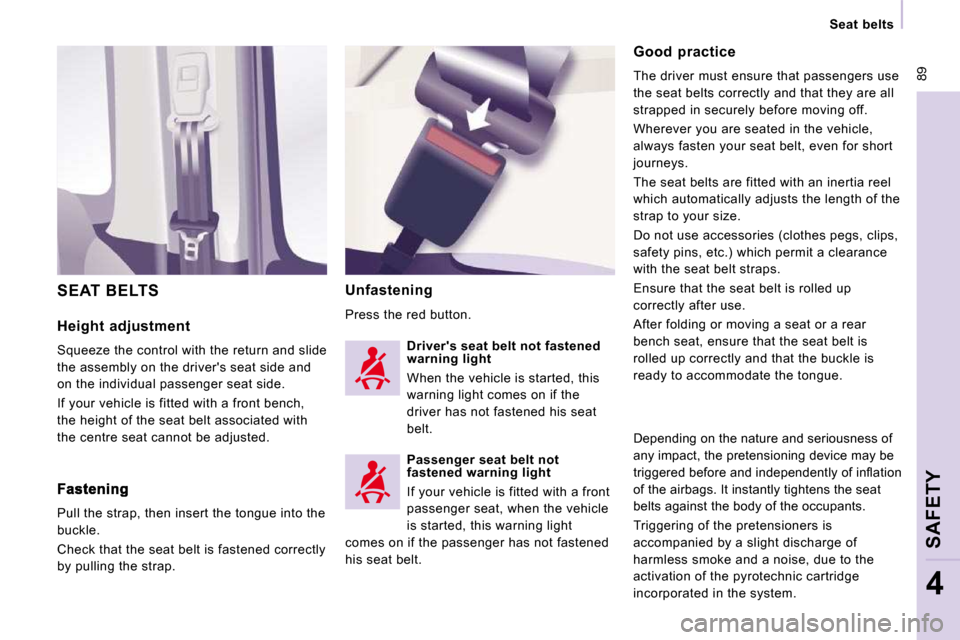belt Citroen JUMPY MULTISPACE 2010 2.G Owner's Manual
[x] Cancel search | Manufacturer: CITROEN, Model Year: 2010, Model line: JUMPY MULTISPACE, Model: Citroen JUMPY MULTISPACE 2010 2.GPages: 235, PDF Size: 11.2 MB
Page 7 of 235

2
4
3
3
11
Interior
FAMILIARISATION
1
Steering wheel Electric windows
Mirrors
36
Seat belts 89 84
82
Adjust the height and depth of the steering
wheel.
Manual adjustments.
Electric adjustments, electric folding/
unfolding.
Height adjustment.
Fastening.
Page 29 of 235

27
Instruments and controls
READY
to
GO
2
Warning light is indicates Solution - action
Coolant
temperature
and level lit with needle in
the red zone.
abnormal increase in
temperature. Park and switch off the ignition then allow to coo
l.
Visually check the level.
flashing. drop in coolant level. Chapter 6, "Lev els" section. Contact a CITROËN dealer.
Service lit temporarily. minor faults or warnings.
Consult the warnings log on the display or on the screen.
See chapter 9, "Trip computer" section then "Warnings log".
Depending on the seriousness of the fault, contact a
CITROËN dealer.
remaining on. major faults.
Row 1 seat belt
not fastened lit then flashing.
the driver or a front passenger
has not fastened his seat belt. Pull the strap then insert the tongue in the buckl
e.
accompanied by
an audible signal
then remains on. the vehicle is moving with the
driver or front passenger seat
belt not fastened. Check that the seat belt is fastened by pulling th
e strap.
Chapter 4, "Seat belts" section.
The driver must ensure that all passengers have
fastened their seat belt and use it correctly.
Page 66 of 235

2-SEAT FRONT BENCH
If your vehicle is fitted with this bench seat,
it is fixed and has a 3rd seat belt.
Head restraint
Press the tab to adjust the height of the
head restraint.
To remove the head restraint, press the tabs
and raise the head restraint.
The adjustment is correct when the upper
edge of the head restraint is level with the
top of the head.
Never drive with the head restraints
removed; they must be in place and
adjusted correctly.
Seat back pockets
If your vehicle is fitted with these, they are
located on the backs of the front seats.
62
Seats
Page 74 of 235

70
Seats
Precautions
Following the various handling operations:
- do not remove a head restraint without storing it and fix it to a support,
- check that the seat belts are always accessible to the passenger and easy to
fasten,
- a passenger must not take his seat without adjusting his seat's head
restraint correctly and adjusting and
fastening his seat belt.
Etiquette
While driving, it is prohibited to have a
passenger:
- in row 3 if the seat back in front (row 2) is in the table position.
- in row 3 if the seat/bench in front (row 2) is in the folded position.
- on the centre seat if the right-hand side seat is in the folded position.
Page 75 of 235

71
Seats
EASE OF USE and COMFORT
3
SEAT AND BENCH CONFIGURATIONS
Examples of various layouts combining comfort and practicality
The various operations must be carried
out while stationary.
7 seats
8 seats
9 seats
5 seats
6 seats
Do not fit seats in the 3rd row without
first fitting the corresponding seatbelts.
Page 94 of 235

89
Seat belts
SAFETY
4
Height adjustment
Squeeze the control with the return and slide
the assembly on the driver's seat side and
on the individual passenger seat side.
If your vehicle is fitted with a front bench,
the height of the seat belt associated with
the centre seat cannot be adjusted.
Unfastening
Press the red button.
SEAT BELTS
Good practice
The driver must ensure that passengers use
the seat belts correctly and that they are all
strapped in securely before moving off.
Wherever you are seated in the vehicle,
always fasten your seat belt, even for short
journeys.
The seat belts are fitted with an inertia reel
which automatically adjusts the length of the
strap to your size.
Do not use accessories (clothes pegs, clips,
safety pins, etc.) which permit a clearance
with the seat belt straps.
Ensure that the seat belt is rolled up
correctly after use.
After folding or moving a seat or a rear
bench seat, ensure that the seat belt is
rolled up correctly and that the buckle is
ready to accommodate the tongue.
Pull the strap, then insert the tongue into the
buckle.
Check that the seat belt is fastened correctly
by pulling the strap. Driver's seat belt not fastened
warning light
When the vehicle is started, this
warning light comes on if the
driver has not fastened his seat
belt.
Passenger seat belt not
fastened warning light
If your vehicle is fitted with a front
passenger seat, when the vehicle
is started, this warning light
comes on if the passenger has not fastened
his seat belt. Depending on the nature and seriousness of
any impact, the pretensioning device may be
�t�r�i�g�g�e�r�e�d� �b�e�f�o�r�e� �a�n�d� �i�n�d�e�p�e�n�d�e�n�t�l�y� �o�f� �i�n�fl� �a�t�i�o�n�
of the airbags. It instantly tightens the seat
belts against the body of the occupants.
Triggering of the pretensioners is
accompanied by a slight discharge of
harmless smoke and a noise, due to the
activation of the pyrotechnic cartridge
incorporated in the system.
Page 95 of 235

Seat belts
The force limiter reduces the pressure of the
seat belt against the body of the occupants.
The pretensioning seat belts are active when
the ignition is switched on.
The inertia reels are fitted with a device
which automatically locks the strap in the
event of a collision or emergency braking or
if the vehicle rolls over.
You can unfasten the seat belt by pressing
the red button on the buckle. Guide the seat
belt after unfastening.
The airbag warning light comes on if the
pretensioners are triggered. Consult a
CITROËN dealer. Recommendations for children:
- use a suitable child seat if the
passenger is less than 12 years old or
shorter than one metre fifty,
- never allow a child to travel on your lap, even with the seat belt fastened. FRONT SEAT BELTS
REAR SEAT BELTS
If your vehicle is fitted with an individual seat
and a 2-seat bench, the 3 seats are fitted
with three-point seat belts and inertia reels.
The centre seat has its seat belt guide and
inertia reel integrated with the seat back.
For further information regarding child
seats, refer to the "Children on board"
section of chapter 4.
In accordance with current safety
regulations, your CITROËN dealer
guarantees all work or any checks, from
testing to maintenance, on your seat belt
equipment.
Have the seat belts checked regularly
(even after a minor impact) by a CITROËN
dealer: they must not show any signs of
wear, cutting or fraying and they must not be
transformed or modified.
Clean the seat belt straps with soapy
water or a textile cleaning product, sold
by CITROËN dealers.
In order to be effective, a seat belt must:
- restrain one person only,
- must not be twisted, check by pulling in
front of you with an even movement,
- be tightened as close to the body as possible.
The upper part of the seat belt should be
positioned in the hollow of the shoulder.
The lap part should be placed as low as
possible on the pelvis.
Do not invert the seat belt buckles as they
will not fulfil their role completely. If the
seats are fitted with armrests, the lap part of
the seat belt should always pass under the
armrest.
Check that the seat belt is fastened correctly
by pulling the strap firmly.
With front airbags
The front seats are fitted with pretensioners
and force limiters.
Without front airbag
If your vehicle is fitted with a front bench
without front airbag, the centre passenger's
seat belt does not have a pretensioner.
In rows 2 and 3, take care to fasten the
correct seat belt in the correct buckle. Do
not invert the seat belt or the buckle of the
side seats with the buckle or the seat belt of
the centre seat.
Page 96 of 235

92
Airbags
The airbags have been designed to maximise
the safety of the occupants (with the
exception of the centre seats of rows 2 and 3)
in the event of a serious collision; they work in
conjunction with the force limiting seat belts.
In the event of a serious collision, the
electronic detectors record and analyse the
front and side impacts suffered in the impact
detection zones:
- in the event of a serious impact, the airbags inflate instantly and protect the
occupants of the vehicle. Immediately after the impact, the airbags
deflate rapidly, so that they do not hinder the
visibility of the occupants nor their possible
exit from the vehicle.
- in the event of a minor or rear impact
and in certain roll-over conditions,
the airbags will not be deployed; the
seat belt alone is sufficient to provide
maximum protection in these situations.
The seriousness of the collision depends on
the nature of the obstacle and the speed of
the vehicle at the moment of impact. It is imperative that the passenger
airbag is disarmed if a child seat is
installed facing rearwards. Refer to the
"Children on board" section of chapter 4. Airbags only operate when the
ignition is switched on.
This equipment only operates once. If a
second impact occurs (during the same or
a subsequent accident), the airbag will not
operate.
The triggering of an airbag or airbags
is accompanied by a slight discharge of
harmless smoke and a noise, due to the
activation of the pyrotechnic cartridge
incorporated in the system.
This smoke is not harmful, but sensitive
individuals may experience some irritation.
The noise of the detonation may result in a
slight loss of hearing for a short time.
AIRBAGS
Page 97 of 235

93
Airbags
SAFETY
4
Good practice
Sit in a normal upright position.
Wear a correctly adjusted seat belt.
Do not leave anything between the
occupants and the airbags (a child, pet,
object...). This could hamper the operation
of the airbags or injure the occupants.
After an accident or if the vehicle has been
stolen or broken into, have the airbag
systems checked.
All work on the airbag system is strictly
forbidden unless it is carried out by qualified
personnel of the CITROËN network. Side airbags
Only put recommended covers on the seats.
These will not hinder inflation of the side
airbags. Consult a CITROËN dealer.
Do not fix or glue anything to the seat backs.
This could cause injury to the chest or arms
when the side airbag inflates.
Do not sit with the upper part of the body
any nearer to the door than necessary.
Front airbags
Do not drive holding the steering wheel
by its spokes or resting your hands on the
centre part of the wheel.
Do not allow passengers to place their feet
on the fascia, they risk serious injury if the
airbag is triggered.
Smoke as little as possible as deployment
of the airbags can cause burns or the risk of
injury from a cigarette or pipe.
Never remove or pierce the steering wheel
or hit it violently.
Even if all of the precautions mentioned are
observed, a risk of injury or of minor burns
to the head, chest or arms when an airbag
is triggered cannot be ruled out. In fact, the
bag inflates almost instantly (within a few
milliseconds) then deflates within the same
time discharging the hot gas via openings
provided for this purpose. Curtain airbags
Do not fix or glue anything to the roof. This
could cause injury to the head when the
curtain airbag inflates.
Do not remove the grab handles installed
on the roof, they play a part in securing the
curtain airbags.
Page 99 of 235

92
Airbags
The airbags have been designed to maximise
the safety of the occupants (with the
exception of the centre seats of rows 2 and 3)
in the event of a serious collision; they work in
conjunction with the force limiting seat belts.
In the event of a serious collision, the
electronic detectors record and analyse the
front and side impacts suffered in the impact
detection zones:
- in the event of a serious impact, the airbags inflate instantly and protect the
occupants of the vehicle. Immediately after the impact, the airbags
deflate rapidly, so that they do not hinder the
visibility of the occupants nor their possible
exit from the vehicle.
- in the event of a minor or rear impact
and in certain roll-over conditions,
the airbags will not be deployed; the
seat belt alone is sufficient to provide
maximum protection in these situations.
The seriousness of the collision depends on
the nature of the obstacle and the speed of
the vehicle at the moment of impact. It is imperative that the passenger
airbag is disarmed if a child seat is
installed facing rearwards. Refer to the
"Children on board" section of chapter 4. Airbags only operate when the
ignition is switched on.
This equipment only operates once. If a
second impact occurs (during the same or
a subsequent accident), the airbag will not
operate.
The triggering of an airbag or airbags
is accompanied by a slight discharge of
harmless smoke and a noise, due to the
activation of the pyrotechnic cartridge
incorporated in the system.
This smoke is not harmful, but sensitive
individuals may experience some irritation.
The noise of the detonation may result in a
slight loss of hearing for a short time.
AIRBAGS